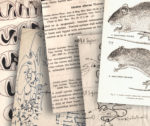Una nueva especie de Philander (Marsupialia, Didelphidae) del mioceno tardío del noroeste Argentino
Francisco J. GoinSe describe una nueva especie de Philander (Marsupialia, Didelphimorphia, Didelphidae) procedente de niveles de la Formación Andalhuala (Mioceno tardío) de la localidad de Tio Punco, provincia de Tucumán (Argentina). Comparada con las especies vivientes del género, la nueva especie es de tamaño relativamente grande y sus premolares y molares son de aspecto robusto; el cráneo tiene las crestas frontales cortas y más transversales al eje craneano; la diastema entre los P1-2 es corta; el cíngulo labial del P3 es incompleto y vestigial; los molares superiores tienen los protoconos más robustos y la postmetacrista del M3 está menos desarrollada.
A new species of Philander (Marsupialia, Didelphidae) from the late Miocene of northwestern Argentina. A new species of Philander (Marsupialia, Didelphimorphia, Didelphidae), from levels of the Andalhuala Formation (late Miocene) at Tio Punco locality, Tucumán province (Argentina) is described. Compared to the living species of the genus, the new species is relatively large and has stronger premolars and molars; the skull has short frontal crests which are more transversally placed regarding the cranial axis; the diastema between P1 and P2 is short; the labial cingulum of P3 is vestigial and incomplete; upper molars have more robust protocones, and the posmetacrista of M3 is less developed.
